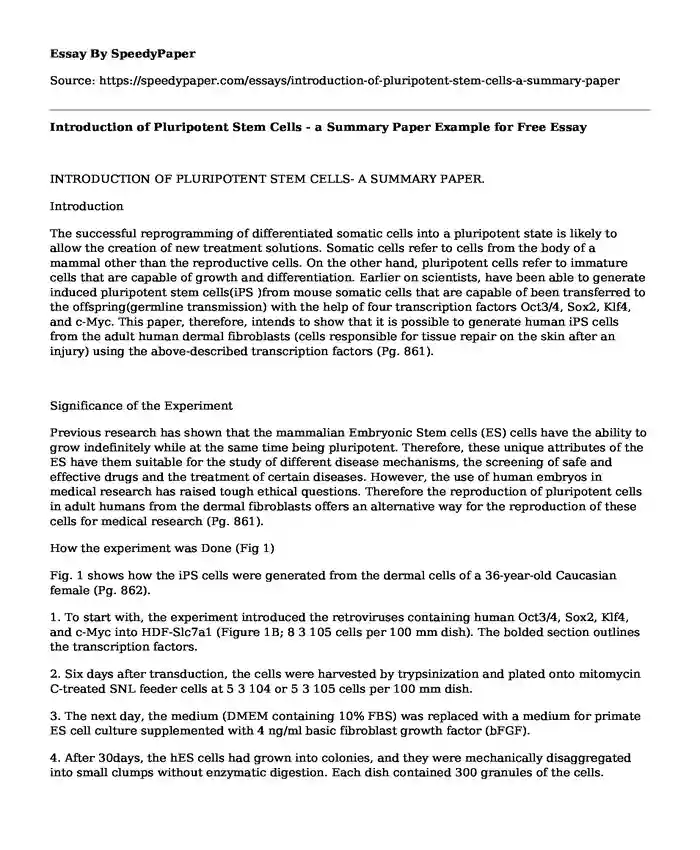INTRODUCTION OF PLURIPOTENT STEM CELLS- A SUMMARY PAPER.
Introduction
The successful reprogramming of differentiated somatic cells into a pluripotent state is likely to allow the creation of new treatment solutions. Somatic cells refer to cells from the body of a mammal other than the reproductive cells. On the other hand, pluripotent cells refer to immature cells that are capable of growth and differentiation. Earlier on scientists, have been able to generate induced pluripotent stem cells(iPS )from mouse somatic cells that are capable of been transferred to the offspring(germline transmission) with the help of four transcription factors Oct3/4, Sox2, Klf4, and c-Myc. This paper, therefore, intends to show that it is possible to generate human iPS cells from the adult human dermal fibroblasts (cells responsible for tissue repair on the skin after an injury) using the above-described transcription factors (Pg. 861).
Significance of the Experiment
Previous research has shown that the mammalian Embryonic Stem cells (ES) cells have the ability to grow indefinitely while at the same time being pluripotent. Therefore, these unique attributes of the ES have them suitable for the study of different disease mechanisms, the screening of safe and effective drugs and the treatment of certain diseases. However, the use of human embryos in medical research has raised tough ethical questions. Therefore the reproduction of pluripotent cells in adult humans from the dermal fibroblasts offers an alternative way for the reproduction of these cells for medical research (Pg. 861).
How the experiment was Done (Fig 1)
Fig. 1 shows how the iPS cells were generated from the dermal cells of a 36-year-old Caucasian female (Pg. 862).
1. To start with, the experiment introduced the retroviruses containing human Oct3/4, Sox2, Klf4, and c-Myc into HDF-Slc7a1 (Figure 1B; 8 3 105 cells per 100 mm dish). The bolded section outlines the transcription factors.
2. Six days after transduction, the cells were harvested by trypsinization and plated onto mitomycin C-treated SNL feeder cells at 5 3 104 or 5 3 105 cells per 100 mm dish.
3. The next day, the medium (DMEM containing 10% FBS) was replaced with a medium for primate ES cell culture supplemented with 4 ng/ml basic fibroblast growth factor (bFGF).
4. After 30days, the hES cells had grown into colonies, and they were mechanically disaggregated into small clumps without enzymatic digestion. Each dish contained 300 granules of the cells.
5. After separation, the hES-like cells started to expand on SNL feeder cells with the primate ES cell medium containing bFGF.
6. At the end of the experiment, these cells were found to be similar to the ES cells in morphology, feeder dependency, and other aspects. These new cells that resemble the hES-like cells are referred to as human iPS cells.
Findings
a. The Human iPS Cells Express hES Markers (Fig. 2)
The human iPS cells generated contained several similarities with the hES cells (Pg. 863):
1. First, it contained proteins levels of OCT3/4, SOX2, NANOG, SALL4, E-CADHERIN, and hTERT similar those in the hES cells (Fig 2.A)
2. The levels of Klf4 and c-Myc increased more than 5-fold in HDF after the retroviral transduction their expression levels in human iPS cells were comparable to those in HDF indicating retroviral silencing (Fig 2A & Fig 2B.
3. DNA microarray analyses showed that the global gene-expression patterns are similar, but not identical, between human iPS cells and hES cells (Fig 2D)
b. Promoters of ES Cell-Specific Genes Are Active in Human iPS Cells (Fig.3)
Figure 3 Demonstrates that particular genes that are present in the ES cells were also present in the iPS Cells. The crust of experiment in fig 3 was to show that the new iPS Cells contained genetic material similar to that in the hES cells but not present in the dermal fibroblasts (Pg. 863).
c. High Exponential Growth of the iPS Cells(Fig.4)
Fig 4. Shows that the iPS Cells showed a high exponential growth which is also a characteristic of the hES cells. The equivalent doubling time per hour of the iPS Cells was found to approximately similar to that of the hES cells (Pg.863).
d. Embryoid Body-Mediated Differentiation of Human iPS Cells (Fig.5)
The experiment in Fig.5 was used to test the differentiation ability of the iPS cells. It was revealed that the iPS Cells could differentiate into three germ layers in vitro similar to ES cells (Pg. 863).
e. Directed Differentiation of Human iPS Cells into Neural Cells (Fig. 6)
The experiment in Fig. 6 was used to examine whether lineage-directed differentiation of human iPS cells could be induced by reported methods for hES cells. The data revealed that demonstrated that iPS cells could differentiate into neuronal cells, including dopaminergic neurons, by coculture with PA6 cells (Pg.864).
f. Teratoma Formation from Human iPS Cells (Fig.7)
Experiment in fig.7 was aimed to determine the pluripotency in vivo of the iPS Cells. Human iPS Cells were transplanted subcutaneously into dorsal flanks of immunodeficient (SCID) mice. Nine weeks later it was revealed that showed that the tumor that had developed contained various tissues including gut-like epithelial tissues (endoderm), striated muscle (mesoderm), cartilage (mesoderm), neural tissues (ectoderm), and keratin-containing epidermal tissues (ectoderm) (Pg. 866).
Conclusion
This experiment has demonstrated that it is possible to generate human iPS cells from the adult human dermal fibroblasts through the use of four transcription factors. The generated iPS cells are similar to the hES cells in several aspects as it has been indicated above. This study has therefore opened an avenue for scientists to examine and develop patient-and disease specific pluripotent stem cells without worrying about using human embryos anymore. Human iPS cells are valuable in understanding disease mechanisms and toxicology studies (Pg. 869).
Cite this page
Introduction of Pluripotent Stem Cells - a Summary Paper Example for Free. (2017, Aug 14). Retrieved from https://speedypaper.com/essays/introduction-of-pluripotent-stem-cells-a-summary-paper
Request Removal
If you are the original author of this essay and no longer wish to have it published on the SpeedyPaper website, please click below to request its removal:
Popular categories





